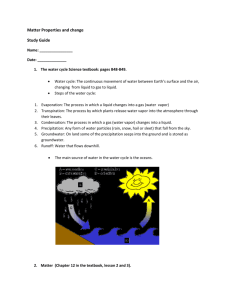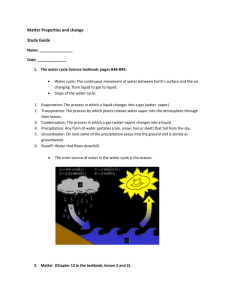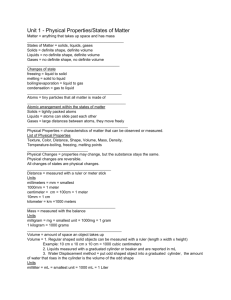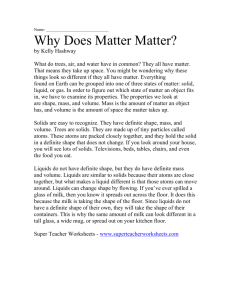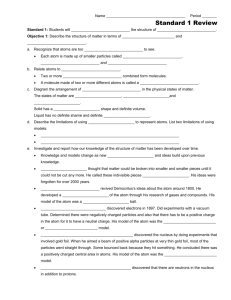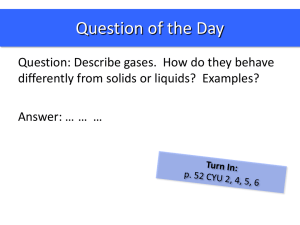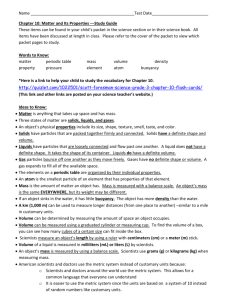Study guide on matter and its properties
advertisement
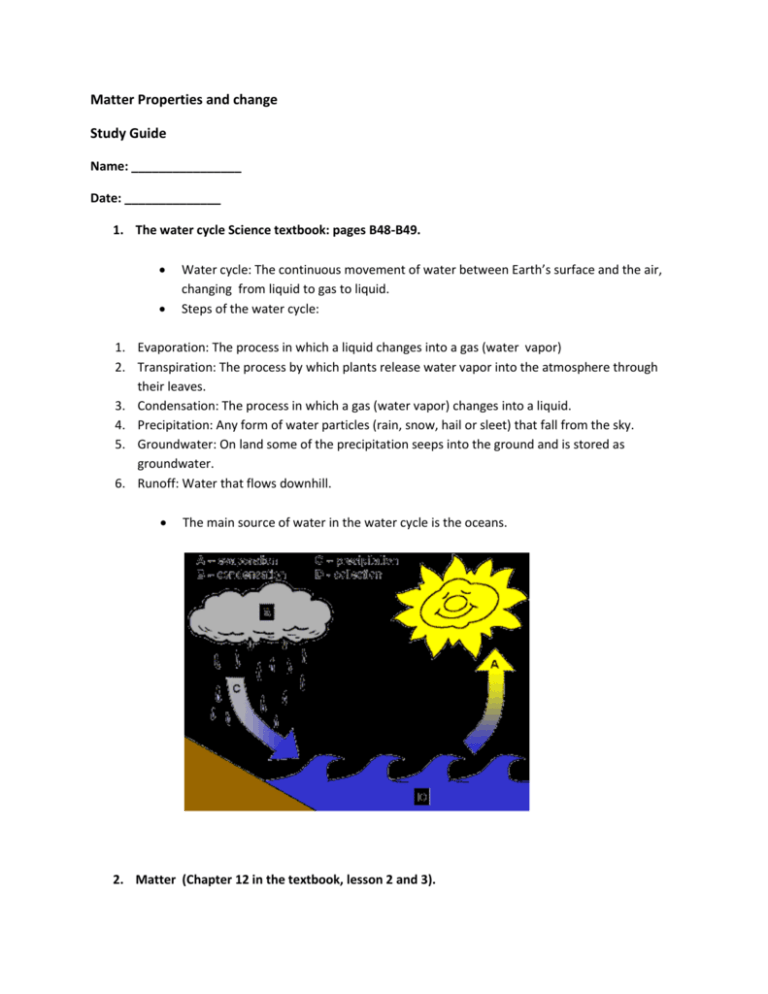
Matter Properties and change Study Guide Name: ________________ Date: ______________ 1. The water cycle Science textbook: pages B48-B49. Water cycle: The continuous movement of water between Earth’s surface and the air, changing from liquid to gas to liquid. Steps of the water cycle: 1. Evaporation: The process in which a liquid changes into a gas (water vapor) 2. Transpiration: The process by which plants release water vapor into the atmosphere through their leaves. 3. Condensation: The process in which a gas (water vapor) changes into a liquid. 4. Precipitation: Any form of water particles (rain, snow, hail or sleet) that fall from the sky. 5. Groundwater: On land some of the precipitation seeps into the ground and is stored as groundwater. 6. Runoff: Water that flows downhill. The main source of water in the water cycle is the oceans. 2. Matter (Chapter 12 in the textbook, lesson 2 and 3). Matter: Anything that has a mass and occupies space. Matter has 3 states: solid, liquid and gas. Mass: The amount of matter in an object. Mass is often measured in kg (kilograms or grams). Volume: How much space a sample of matter takes up. Volume is often measured in mL (milliliters: mL). Weight: The force of gravity between the Earth and an object. The weight is measured in N (Newtons). On the moon you would have the same mass, but you would weigh less than on Earth because the mass of the moon is less than Earth, so the force of gravity between your body and the moon would be less. Density: The quantity of matter in an object. How massive an object is for its size. It compares an object mass with its volume. If an object is denser than water, it will sink. If it is lighter than the water density, it will float. Matter is made up of atoms. Atom: Tiny particles that cannot be cut into smaller pieces. Atoms contain 3 kinds of particles in their center, called the nucleus: Protons (positive electric charge), neutron (no electric charge) and electrons (negative electric charge) that move around the nucleus. Atoms join together to form molecules. Molecule of elements contain only one kid of element. Examples: O2 (Oxygen), N2 (Nitrogen). Element: One kind of atom. Pure substance. Elements cannot be further broken down into other substances. There are 112 elements. Examples: Copper, Aluminum, Mercury. Compounds: 2 or more elements that combine form a compound. Compounds are made up of molecules that have different kinds of atoms joined together. Compounds are different from the elements that make them. Example: H2O (water), CO2 (carbon dioxide) 3. Matter and its properties Matter has 2 types of properties: Quantitative and qualitative. Qualitative properties Color Texture Appearance Smell Taste Comparison of some properties of solids, liquids and gas: Types of matter Solids Shape Definite shape. Shape does not change Liquids Indefinite shape. Liquids change shape. Indefinite shape. Gas Quantitative properties I can measure them. Mass Volume Temperature Density Volume Definite volume. The volume in solids does not change. It stays the same. Definite volume. The volume does not change. It stays the same. Indefinite volume. They fill the whole recipient. Mass Definite mass. The mass does not change. Definite mass. The mass does not change. Definite mass. The mass does not change. Another property of matter is temperature. I can measure temperature in Celsius or Fahrenheit. Celsius Fahrenheit Water boils At 100 C At 212 F Water freezes At o C At 32 F 4. Changes of matter Matter can change. Matter at the beginning A liquid (water) A liquid (water) A solid (ice) A gas (water vapor) Matter transforms into another type of matter A gas (water vapor) A solid (ice) A liquid (water) A liquid (water) Name Evaporation/vaporization freezing Melting Condensation MATTER AND ITS PROPERTIES /28 NAME: _________________ DATE: _________________ A. Choose the correct answer. /10 1. An atomic particle that has a positive charge is called an : A. An electron B. A neutron C. A proton D. A compound 2. An object ability to float depends on its _____________. A. Size B. Temperature C. Insulation D. Density. 3. Mass is the measure of the ____________________. A. Amount of material in an object. B. Weight of an object. C. Space an object takes up. D. Density of an object. 4. The molecules of a _____________ tend to be packed tightly in an organized way. A. Gas B. Solid C. Liquid D. Neutron 5. ____________ is anything that has a mass and occupies space. A. A solid B. A liquid C. A gas D. Matter 6. ___________ is how much space a sample of matter takes up. A. Mass B. Weight C. Volume D. Density 7. A measure of the force of gravity between Earth and an object is its _________. A.Mass B. Volume C. Weight D. Density 8. The smallest unit of an element is an ___________ A.Molecule B. Atom C. Compound D. Gas 9. In the center of an atom, there is a _____________ A.Molecule B. Element C. Compound D. Nucleus 10. Matter has 2 types of properties. The properties that you can measure like temperature, mass, volume, density are the ______________ properties. A. Boiling B. Negative C. Qualitative D. Quantitative B. Scientists use a variety of models to understand and explain the natural world. A formula such as H2O is a model for water. Tell what the formula means. Give another example of a chemical formula and tell what it means. /2 C. What is the main difference between mass and weight? Support your answers with details. /3 D. Explain how the atoms are arranged in solids, liquids and gas. /3 E. Draw the inside of an atom. Label the different parts. /4 F. Explain what experiment you could do to demonstrate that a gas has a weight? /1 G. Explain what experiment you could do to demonstrate that a liquid’s volume does not change. /1 H. Samantha went to the grocery store and bought fruit, meat, a few boxes of cereal and a few canned items. Once at home, Samantha weighed the bag. It weighed 35lb. How many pounds do the canned items weigh if the bag weighs 1 lb, the fruit 4lb, the meat 7lb and the boxes of cereal weigh 2 lb? /1 __________________________________________________________ I. A student is performing an investigation in science class. Her hypothesis is that a glass of tea will weigh more after a teaspoon of sugar is dissolved in it. How can the student test this hypothesis? /2 Is her/his hypothesis right? Explain why. /1
